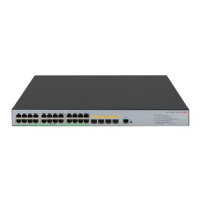397
Ste
Command
Remarks
3. Configure an IPv6
multicast forwarding
boundary.
multicast ipv6 boundary
{ ipv6-group-address prefix-length | scope
{ scope-id | admin-local | global |
organization-local | site-local } }
By default, no multicast forwarding
boundary is configured.
Configuring C-BSRs for IPv6 admin-scope zones
In a network with IPv6 administrative scoping enabled, BSRs are elected from C-BSRs specific to different
Scope field values. The C-RPs in the network send advertisement messages to the specific BSR. The BSR
summarizes the advertisement messages to form an RP-set and advertises it to all routers in the specific
admin-scope zone. All the routers use the same hash algorithm to get the RP address corresponding to
the specific IPv6 multicast group.
You can configure the hash mask length and C-BSR priority globally and in an IPv6 admin-scope zone.
• The values configured in the IPv6 admin-scope zone have preference over the global values.
• If you do not configure these parameters in the IPv6 admin-scope zone, the corresponding global
values will be used.
For configuration of global C-BSR parameters, see "Configuring C-BSR parameters globally."
P
erform the following configuration on the routers that you want to configure as C-BSRs in IPv6
admin-scope zones.
To configure a C-BSR for an IPv6 admin-scope zone:
Ste
Command
Remarks
1. Enter system view.
system-view
N/A
2. Enter IPv6 PIM view.
pim ipv6 N/A
3. Configure a C-BSR for an
IPv6 admin-scope zone.
c-bsr scope { scope-id | admin-local |
global | organization-local | site-local }
[ hash-length hash-length | priority
priority ] *
No C-BSRs are configured for an
IPv6 admin-scope zone by default.
Configuring IPv6 multicast source registration
Within an IPv6 PIM-SM domain, the source-side DR sends register messages to the RP, and these register
messages have different IPv6 multicast source or IPv6 multicast group addresses. You can configure a
filtering rule to filter register messages so that the RP can provide services for specific IPv6 multicast
groups. If the filtering rule denies an (S, G) entry, or if the filtering rule does not define an action for this
entry, the RP will send a register-stop message to the DR to stop the registration process for the IPv6
multicast data.
In view of information integrity of register messages in the transmission process, you can configure the
device to calculate the checksum based on the entire register messages. However, to reduce the
workload of encapsulating data in register messages and for the sake of interoperability, H3C does not
recommend this method of checksum calculation.

